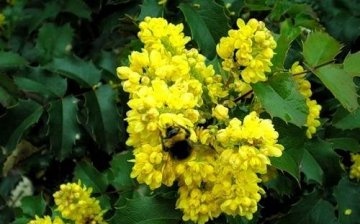Mahonia holly in the photo. Growing Mahonia holly
Mahonia holly is an evergreen shrub up to two meters high. This plant belongs to the barberry family. Unfortunately, it is rarely cultivated by gardeners, although it is very decorative, rather unpretentious and gives dark blue berries rich in vitamin C, which are quite suitable for making jams and jams. Blooming Mahonia holly in the photo looks very impressive, its dark glossy leaves and its yellow drooping inflorescences are beautiful. Due to its decorative effect, this plant is often used in landscape design.
Mahonia grows on any calcareous soil. In the middle lane, in cold winters with little snow, it sometimes freezes out, but quickly grows back and recovers. This plant belongs to centenarians; with proper progress, the bush will live in one place for about 70 years. Mahonia blooms more abundantly in sunny places, but it is better preserved in partial shade, which protects the plant from the bright sun in spring. Mahonia is resistant to diseases and pests, and tolerates urban conditions well.
Mahonia holly reproduces vegetatively and by seeds. It is better to sow seeds in September in open ground, since long stratification is required during spring planting. Those gardeners who plan to grow Mahonia for the sake of obtaining berries need to plant at least two bushes for cross-pollination. The yield will depend on how successful the pollination is. The holly magnolia in the photo with berries looks no less beautiful than with flowers. Its leaves acquire a bronze hue, and gray or dark blue berries are collected in large clusters.



